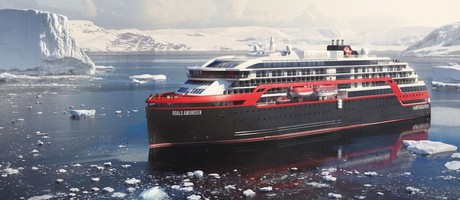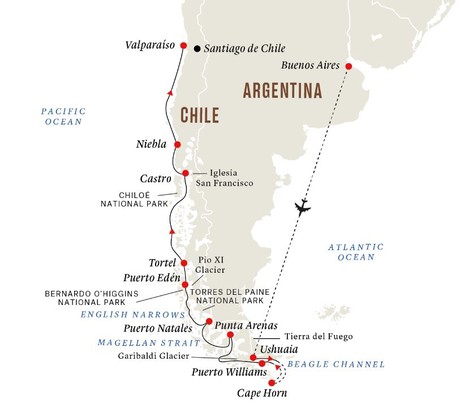Chilean Fjords – Discovering the Heart of Patagonia Expedition
Join our expedition cruise through Patagonia and the Chilean fjords from Ushuaia to Valparaíso. You’ll visit remotenational parks and make approaches to both Garibaldi and Pio XI glaciers. The beginning of an adventure Begin with a night in romantic Buenos Aires before flying to Ushuaia to meet hybrid-powered ship MS Roald Amundsen. We’ll go straight into adventure mode and attempt a landing at Cape Horn. Waves from the Pacific and the Atlantic converge here, often creating challenging conditions. This fact just makes it all the more exciting if we do succeed in going ashore. You’ll then continue to the small town of Puerto Williams and we’ll try cruising into Garibaldi Fjord, a UNESCO Biosphere Reserve and home to a glacier of the same name. Patagonia’s National Parks Arriving in Puerto Natales, you may have the opportunity to join an optional excursion to the world-renowned Torres del Paine National Park. Next is Pio XI, the longest glacier in the southern hemisphere outside of Antarctica. The isolated but inviting communities of Puerto Edén and Caleta Tortel follow. Castro is a charming rustic city with access to Chiloé National Park while Niebla and its old Spanish fortress is your last stop before the vibrant hilltop city of Valparaíso.
Highlights
• A night in romantic Buenos Aires
• Visit the small town of Puerto Williams and we’ll try cruising into Garibaldi Fjord, a UNESCO Biosphere Reserve and home to a glacier of the same name.
• Join an optional excursion to the world-renowned Torres del Paine National Park.
• Visit Pio XI, the longest glacier in the southern hemisphere outside of Antarctica. The isolated but inviting communities of Puerto Edén and Caleta Tortel follow.
• Enjoy Castro, a charming rustic city with access to Chiloé National Park while Niebla and its old Spanish fortress is your last stop before the vibrant hilltop city of Valparaíso.
There’s a beat to Buenos Aires that is unmistakably unique to the capital of Argentina. Ask any who live here, and they’ll tell you it is the melting-pot community of locals who imbue the city with such vibrancy. As porteños, ‘the people of the port’, they came from across the globe, bringing a diverse set of cultures with them. The result is an intoxicating blend of romance music, people dancing the tango at almost every opportunity, Maradona-mad football fans, Old World colonial architecture, and flavoursome Latin food. You’ll be spending one night at a hotel in the city before catching an early flight the next morning. Depending on when you arrive, you might have some time to explore a little of this lively capital. Visit Teatro Colón, a beautiful opera house that dates back to 1908 and then pop into historic Café Tortoni for Paris-inspired coffee and chocolate-dipped churros. Caminito is a colourful street museum in La Boca neighbourhood that features buzzy markets and restaurants that host live folk dance and tango shows. To carry on the party mood late into the night, the posh district of Palermo has bars and boliche clubs aplenty. Arrange to arrive in Buenos Aires a few days earlier to fully explore or to join our optional Pre-Programme to wild Patagonia.
It’s an early start today. We meet in the lobby of the hotel in the morning and head to the airport for our flight to Ushuaia. The capital of Argentina’s Tierra del Fuego province sits on the shores of a bay backed by the snow-coated mountains of the Martial Glacier to the north. Ushuaia claims the dubious title of the world’s southernmost city, although this is contended by two other Chilean cities. Your basecamp at sea, MS Roald Amundsen, waits in the port here. Once on board, you’ll pick up your complimentary wind and water-resistant expedition jacket and attend a mandatory safety drill before departure. Afterwards, you have some time to tour the ship and to settle in your cabin before we enjoy a welcome dinner together. Your expedition is officially underway!
In the morning, we will sail through the scenic Beagle Channel, where you can watch for rare, endemic Peale’s dolphin and other wildlife. Once we exit the channel, we journey down to legendary Cape Horn. This headland on Hornos Island was discovered in 1616 by the Dutchman Willem Schouten, who named it Kaap Hoorn after the city of Hoorn in the Netherlands. For centuries, it was a major milestone in the old clipper routes that connected Europe with the Far East and Oceania. It is still a monumental point on round-the-world sailings today. The area around the island is where the open waters of the Atlantic and Pacific collide, creating powerful waves that are made even stronger by swirling westerly winds. For yachters, rounding Cape Horn is a maritime feat akin to summiting Mount Everest. Given the notoriety of these turbulent waters, we can’t guarantee you a landing. But if fortune favours us on the day with weather stable enough to set foot on the island and go up to the cape, you’ll be among a select few in the world able to boast about it.
Located on Isla Navarino, in between the Dientes de Navarino mountain range and the southern bank of the Beagle Channel, there are few places that feel as ‘end of the road’ as Puerto Williams. While it is one of three contenders for the title of ‘The World’s Southernmost City’, Puerto Williams has a quiet atmosphere more akin to a small town. Why not go to the post office here and send friends and family a postcard? They’ll probably be thrilled to receive a message from you all the way from ‘the end of the world’. The city began as a military outpost in 1953 and most of its 3,000 residents are attached to the local naval base. Around 70 of the indigenous Yahgan people also call Puerto Williams home, living in the Tierra del Fuego region for 10,000 years. For the history of the people and of the city, it is well worth dropping into the Martin Gusinde Anthropological museum. There, you can examine Yahgan artifacts, maps, photographs, and a traditional canoe. You might like to see a replica of the bow of the Yelcho – the ship that rescued Shackleton’s men who were stranded on Elephant island in 1916. There’s also the option for you to go for walks and immerse yourself in the gorgeous scenery, whether on your own or as part of a guided optional excursion. If the weather is nice, there might be opportunities to do optional kayaking too. Keen birdwatchers should have their binoculars at the ready to spot a range of seabirds, including the mighty albatross.
The goal for the day is to go for a scenic cruise in Garibaldi Fjord in Alberto de Agostini National Park, all the way up to Garibaldi Glacier. This is a stunning region where the Andes tumble into the Pacific and great glaciers feeds ice, and sometimes icebergs, into the beautiful Chilean fjords. The waters are stained with glacial sediment, giving them a creamy blue appearance while the sheer cliffs glisten with ribbons of waterfalls, perhaps in full flow from recent rainfall. From our experience on past sailings here, the area can sometimes have strong winds as well as thick sea ice which may block our route. But, if weather and waters are kind, you’ll get to arrive at Garibaldi Glacier at the head of the fjord, one of the most impressive glaciers in all of Chile. The wall of crumbling sapphire and teal-coloured ice towers taller than some buildings. A confetti of ice of all shapes, shades, and sizes covers the waters beneath it. While we can’t guarantee this experience while we are at the glacier, you just might witness chunks of the glacier calve off the wall, plunging and crashing below in an explosion of ice and water. More than the sight of this spectacle, it is the dramatic sound, reverberating through the fjord, which is likely to leave the deepest impression on you. Thanks to the oxygen-rich, plankton-packed cold waters that emanate from the glacier, the fjord is also recognised as part of a UNESCO Biosphere Reserve. Seals and sea lions may poke their heads out of the water or be seen on the shores. A range of seabirds also soar above or perch on miniature islands of floating ice. One notable silhouette for you to spot the sky is the Andean condor, a member of the vulture family with a wingspan as wide as three metres.
This wild and remote region was once the domain of canoe-faring indigenous people who lived, sailed and hunted in these very fjords for centuries. Admire the serenity of this maze of waterways, surrounded by islands, glaciers and steep mountains. Go out on deck and bask in the views of the high mountains plunging into the icy water while looking for wildlife like elephant seals, dolphins and whales. Throughout your journey, the Expedition Team will be running lectures in the Science Center to share their extensive knowledge of the region with you. Topics could include periods of pre-Columbian history, the geology of the surrounding mountains and islands, folklore of local communities, and so on. But not all lectures are confined to indoors. If the ship attracts seabirds who come to fly alongside us, the Expedition Team might also help you spot and identify these feathered followers out on deck. There is also a designated photographer on board who, in addition to taking pictures from our journey together, will be available to help you with the basics of expedition photography.
On our way in and out of Puerto Natales, we will have to sail through the White Narrows – a passage only 80 metres wide. These narrows require careful navigation as we can only pass them in the daylight and at slack tide. The city of Puerto Natales was originally founded in 1911 by Scottish and German immigrants who came to export lamb and wool back to Europe. Today, the city has around 20,000 inhabitants and receives a regular influx of adventure travellers from all over the world on their way to the world-renowned Torres del Paine National Park. Join our optional excursion to the park to discover a landscape of stunning variety, from vast open steppes to rugged mountain terrain topped by looming peaks that host a variety of wildlife. Watch for llamas, pumas and foxes, in addition to more than 100 species of birds, like the Andean Condor. You can also spend time in Puerto Natales itself. The city has seen a rise of trendy eateries, Bohemian-type bars and stores selling all sorts of outdoor gear. Gin lovers can take a tour of the Last Hope Distillery, which may be the southernmost distillery in the world, or head to Etherh Aike, an artisan village selling various crafts and gifts. The waterfront in particular has many photogenic sites, such as the old pier with its wooden posts meandering into the fjord and snow-topped mountains in the background. The fingers of the Hand Monument and the dancing figures of the Wind Monument will make for worthy holiday snaps too. We’ll sail very early the second day, but the ship will spend the night alongside port.
Emerging from the Southern Patagonian Ice Field at almost 66 kilometres in length, Pio XI Glacier is the longest glacier in the southern hemisphere outside of Antarctica. Also known as Brüggen Glacier after the German geologist, it has a wall spanning 4.5 kilometres wide and 80 metres high, marked by intricate cracks and deep crevasses. Incredibly, Pio XI is unique in Bernardo O’Higgins National Park as the only glacier to be advancing year after year. In fact, it appears to buck the trend of most glaciers in the world which are generally in retreat, instead boasting an average advance in length, height and density as much as 50 metres a day. To reach the glacier, we’ll sail east through Eyre Fjord where you can admire the scenery all around you. Temperate forest lines the shores, sometimes with sea lions in the foreground. Dolphins are also known to swim the waters, accompanied by seabirds like gulls and terns above. If weather and wave conditions are right, we’ll launch our small boats to explore the fjord and glacier, taking care to not get too close. Ice occasionally calves off the Pio XI’s wall into the waters below, creating a thrilling sight and sound to behold – from a safe distance!
The settlement of Puerto Edén sits at the edge of a peninsula in a fjord of Bernardo O´Higgins National Park. While the park is certainly a paradise off the beaten path, Puerto Edén is only accessible by sea and one of Chile’s most hard-to-reach inhabited places. To get here, we have to sail through the English Narrows, a passage at the south end of the Messier Channel that can only be navigated at slack tide and in daylight. The narrows are only 180 metres wide in places, with low-lying islands and steep mountains on both sides where the evergreen trees of Magellanic subpolar forests grow. Puerto Edén’s isolation is in part also due to the climate of the region which is typified by frequent rainfall, high humidity and heavy storms. There are no roads to, from or even within the village, just boardwalks and footpaths that connect the homes of its fewer-than 200 inhabitants. The village is also home to the last known community of two dozen indigenous Kawéskar people. The unique community is designated a Living Human Treasure by UNESCO, recognising the people’s cultural significance and the need to protect their heritage. You can walk freely through the village and meet and chat to local inhabitants. You’ll admire their synergy with local plants and marine animals, and no doubt respect their desire to preserve their precious history and customs.
South of the San Rafael Laguna National Park, in between the Northern and Southern Patagonia ice fields, you’ll find Caleta Tortel, a remote village at the mouth of Rio Baker, the largest river in Chile. A single road to Caleta Tortel opened in 2003, allowing the village to be less isolated than it once was. Thanks to the melting ice of the surrounding glaciers, the waters here are an eye-catching mixture of turquoise and milky-blue colours. If the weather cooperates, you’ll be able to get up close to the water on a kayaking excursion. The village sprang up as part of the timber industry, which explains why most of the village is made entirely from wood sourced from Guaitecas cypress trees in the surrounding forest. Common throughout the Aysén region, migrant workers from Chiloé in the north came here to work, and typical of Chilotan style, many of the houses are constructed on stilts. Now, the 500 people make up a close-knit community still connected to the logging trade and includes a school, library, medical centre, police station and even some restaurants. There are no streets within the village per se, but instead a maze of boardwalks that weave over the water and around the mountain base which you can wander around. A tour of the village with a local guide is also available as an optional excursion. The locals are known to give guests a warm welcome, and you might be treated to a performance by folk dancers and locals selling handicrafts. You can also learn about the area’s fascinating history which includes the discovery of 8,000-year-old cave paintings and evidence that the unique Chilesaurus roamed the region 145 million years ago.
Your expedition cruise continues north through the fabled waters of Patagonia. It is thought that when Magellan sailed here in 1520 on his circumnavigation of the earth, he and his crew somehow imagined the natives to be giants of up to 5 metres in height. He therefore named them ‘Patagons’ after a related literary character in a Spanish novel popular at the time. While the natives were slightly taller than most Europeans then, they were far from giants. The name, however, stuck and thus was the region introduced to the world as Patagonia. Today, it is famed more for the beautiful Andean seascape rather than the alleged giants, even though you might actually spot another species of giant swimming and breaching in the water. There are still interesting lectures to attend, perhaps about seabirds, geography or indigenous culture. Maybe join an Art Workshop where you can paint something from your experiences so far or pick one of the proposed Citizen Science projects in the Science Center.
Set amidst windswept hills and lush green flora, Castro is the capital of Chiloé Island. Most visitors make a beeline for Gamboa wharf district to see the famous palafitos, brightly painted wooden houses built atop stilts along Fiordo de Castro. But this little big city has so much more to offer. Fancy antiquities? Head down to the main town square to visit the UNESCO World Heritage site, Iglesia San Francisco, an old wooden Neo-Gothic church dating back to the founding of the city in 1567. If your taste leans more towards the contemporary, the Museum of Modern Art of Chiloé is worth a visit. If you get hungry on your way through town, stop into one of the city’s many great restaurants. You may also have an opportunity to book an optional excursion into nearby Chiloé National Park. This walk will take you through the park’s Valdivian rainforest made up of evergreen southern beech and native alerce conifers, the largest tree species in South America. If you’re lucky, you might even catch sight of sea lions, sea birds and whales along the shore.
The small seaside town of Niebla is set on a picturesque peninsula with views of Corral Bay on one side and the mouth of Valdivia River on the other. Its name is Spanish for ‘fog’, which is known to roll into the area at times carried by winds off the Pacific. Locals from the nearby city of Valdivia like to visit Niebla for its lively folk market and dark sand beach. Take a stroll on the wide beach and, if the market Feria Costumbrista is open, you can also sample your choice of traditional empanadas, antichuchos, churros and more. Aside from the town itself, you’ll likely spend most of your time here exploring the ruins of the old Spanish fort and its associated museum. Castillo de la Pura y Limpia Concepción de Monfort de Lemus, or just Niebla fort for short, was built by the Spanish between 1671 and 1679. It is one of four main fortresses and, together with a network of other small battlements, once protected ships and towns from pirates who used to roam the waters and raid the communities. Learn more about the region’s strategic history in the museum, walk around the lighthouse, pose next to the row of rusted canons, and take in the beautiful views across the river and bay.
Your expedition cruise is coming to an end, but it is not over yet. We recommend making the most of your remaining time on MS Roald Amundsen, whether you prefer scouting for more birds and wildlife out on deck, talking to your new friends or enjoying your favourite drink in the Explorer Lounge & Bar. The Expedition Team will recap the highlights of your cruise and keep you engaged. Our onboard photographer may even present a slideshow of photos taken on your adventurous expedition cruise.
Your voyage ends when we reach the seaport of Valparaíso. Built on steep hillsides overlooking the ocean, the UNESCO-listed city is a maze of monuments, churches, historical funicular lifts, trendy barrios, cobblestone alleys, colourful houses and charming plazas. Cerros Alegre and Concepción have probably the best views while the historic port district boasts colonial architecture, bustling mercados, and the maritime and modern art museums. You’ll likely be fascinated by this colourful and unusual city, so why not arrange to stick around for an extra day or two. From here, you also join a Post-Programme to Easter Island, famous for its mysterious statues of giant heads.
Itineraries are subject to change.
|
Book now |
Polar Outside. From
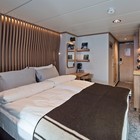
Arctic Superior. From
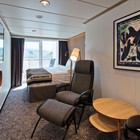
Expedition Suite. From
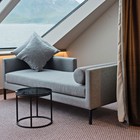
Vessel Type: Expedition Ship
Length: 140 metres
Passenger Capacity: 530
Built: 2019
In 2019, Hurtigruten adds a brand new ship to its fleet: the MS Roald Amundsen. The state of the art vessel features new and environmentally sustainable hybrid technology that will reduce fuel consumption and show the world that hybrid propulsion on large ships is possible.
MS Roald Amundsen is the first of two hybrid ships Hurtigruten will add to its fleet over the next few years, cutting emissions by sailing with electrical propulsion. Hybrid technology, combined with the advanced construction of the hull and effective use of electricity on board will reduce fuel consumption and CO2-emissions on the ships by 20 percent. The build of these two ships represents the largest single investment in the history of Hurtigruten.
The future of shipping will be silent and emission free. MS Roald Amundsen will lead the way towards an even more sustainable way of traveling. Sailing on electrical power is not only a great benefit for the environment, but it will also enhance the impact of experiencing nature for the guests. The ship will be specially constructed for voyages in polar waters and serve as a comfortable basecamp at sea – bringing adventurers from all over the world to the most spectacular destinations in the most sustainable way.
Facilities on board
One of the most eye-catching exterior design features of the ships will be the two-level indoor/outdoor Observation Deck wrapped around the top of the ships’ raked bow. In a vast area behind it, you’ll find the core of the onboard experience: Amundsen Science Center.
Packed with state of the art technology and high tech gadgets such as touch screens and science equipment, the immersive edutainment area will be the place guests and staff/crew meet, mingle and create a deeper understanding for the areas they explore. The flexible venue will feature lecture spaces, a small library, and speciality areas for workshops in photography, biology, and more. The area, featuring large windows, will also be the onboard HQ for Hurtigruten’s hand picked Expedition Team.
The stunning scenery will be reflected in a rich and comfortable interior design. Scandinavian materials from nature, such as granite, oak, birch and wool will be used to create relaxed and stylish cabins and public areas. All cabins are outside, 50 % will have private balconies, aft suites will feature private outdoor Jacuzzis with spectacular views.
MS Roald Amundsen will feature three restaurants inspired by Nordic and Norwegian heritage:
Aune Main Dining, named after the Norwegian ship chandler and polar expedition supplier Tinus Aune.
Fredheim - the ships’ informal and social meeting place – named after a 1900s hunting station on Svalbard.
Lindstrøm, a speciality restaurant named after Adolf Lindstrøm, the favorite chef of the Norwegian polar heroes.
Artwork on board
When the world’s first hybrid powered expedition ship embarks on her maiden voyage, every piece of art on board will be handpicked by HM Queen Sonja of Norway’s art foundation - the Queen Sonja Print Award. Read more about the exciting collaboration here.









Inclusions
HX Expedition voyages include
• Voyage on board in selected cabin category
• On board lectures
• Daily expeditions and activities such as hikes, community visits, talks and more
• Full board dining, including breakfast, lunch and dinner with house wine and beer
• Wine, beer, spirits and cocktails available across the day and evening
• All-day coffee, tea & soft drinks
• Free Wi-Fi
• Gratuities
• Our interactive science programme, Science Centre and activities both on and off the ships
• Access to sauna, hot tubs, fitness room and more
• Professional photos from the onboard photographer
• Opportunities to engage with and support local communities and environmental initiatives through Hurtigruten Foundation.
• Take home expedition jacket and reusable water bottle
• Expedition photographers on hand to assist you
Coastal Express include
• Full board (breakfast, lunch, and dinner) from Norway's Coastal Kitchen
• Norwegian- and English-speaking Coastal Experience Team on board
• Engaging onboard activities and lectures:
• Onboard lectures and presentations on Norway’s history, biology, geography, geology, and culture
• Introductory photo presentation, camera adjustment and tips and tricks, photo and film footage from the voyage
• A welcome event, and daily gatherings to recap the day and prepare for the day to come
• Presentations about the ports we visit
• Presentation of excursion programmes
• Point of interest presentations out on deck
• Captain’s dinner and a farewell event
• Overnight in Buenos Aires before the expedition cruise, including breakfast
• Flight in economy class from Buenos Aires to Ushuaia
• Transfer from the hotel in Buenos Aires to Buenos Aires airport before the expedition cruise
• Transfer from Ushuaia airport and the ship, including a brief tour of the town
Exclusions
• International and domestic flights unless otherwise stated
• Passport and visa costs where applicable
• Travel insurance
• Transfers unless otherwise stated
• Optional Excursions
• Pre and Post voyage accommodation
• Beverages on board unless otherwise stated (Premium drinks (top shelf spirits, vintage wines, champagne, etc.)
• Meals while ashore
• Optional treatments in the onboard wellness and spa area
• Some specialist excursions and experiences with limited capacity
• Fine dining in our Lindstrøm restaurant
• For those who want to set sail in style for a little bit extra, our Expedition Suites offer a complimentary bottle of champagne, unlimited access to our Lindstrøm fine dining restaurant, laundry and turn-down service and more.
Notes
• All planned activities are subject to weather conditions
• Excursions and activities are subject to change
• Please make sure you meet your entry and boarding requirements
Our Associates Include













